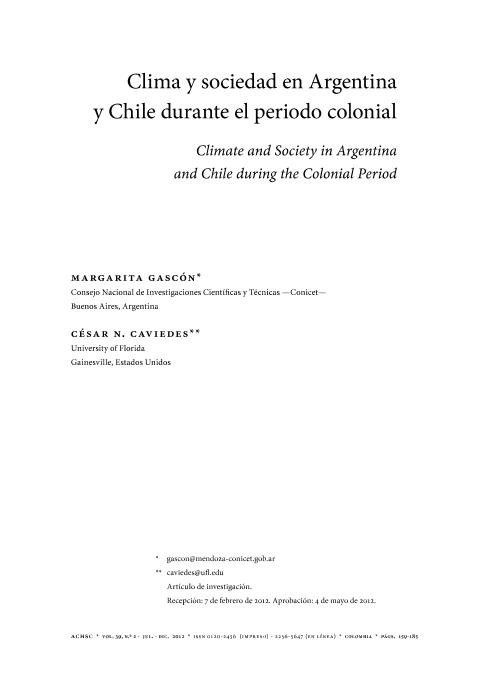Artículo
El artículo analiza las principales fluctuaciones climáticas globales en algunos territorios, que actualmente pertenecen a las repúblicas de Argentina y de Chile, durante el periodo colonial. Las colonias involucradas son Santiago, en Chile; y Mendoza, Córdoba y Buenos Aires, en Argentina. El periodo colonial inicia con la Pequeña Edad Glacial y sus condiciones de mayor frío y humedad; a mediados del siglo XVII fue notorio el Mínimo de Maunder; y, finalmente, en la segunda mitad del siglo XVIII, se registró el Remonte Termal, caracterizado por el calor y la sequía. Prestamos atención a El Niño Oscilación del Sur (ENOS) en sus diferentes efectos locales. El objetivo principal es enriquecer las interpretaciones del pasado desde finales del siglo XVI hasta principios del siglo XIX, al aportar elementos referidos a la historia del clima. El eje del análisis es que el clima afecta los ambientes y los recursos naturales disponibles, la vida urbana y las rutas, de modo que no puede estar ausente de las diversas explicaciones del pasado colonial. The article analyzes the main climatic fluctuations during colonial times in territories that currently belong to the republics of Argentina (Mendoza, Córdoba and Buenos Aires) and Chile (Santiago) during colonial period. The communities under consideration are Santiago in Chile, and Mendoza, Cordoba and Buenos Aires in Argentina, though data is occasionally provided about Paraguay and Uruguay. The area is located in the extra-tropical third of the continent. The Little Ice Age was a period of increasing rains and cold weather, which began almost at the same time the Spaniards arrived in the Americas. The Maunder Minimum happened by the middle of seventeenth century. Finally, the Thermal Remount inaugurated a long period of drought and hot weather, which was acute in the second half of the eighteenth century. Special attention is devoted to the ENOS (El Nino Southern Oscillation) and its different effects in the areas under consideration. The main objective of the paper is to enrich interpretations of the colonial past, from the end of the sixteenth century to the early nineteenth century, by providing information about the climate. The guiding hypothesis is that since climate affected the diverse environments, the availability of natural resources, urban life, and trading routes, it cannot be excluded from the many explanations of colonial times.
Clima y sociedad en Argentina y Chile durante el periodo colonial
Título:
Climate and society in Argentina and Chile during the colonial period
Fecha de publicación:
08/2012
Editorial:
Universidad Nacional de Colombia. Facultad de Ciencias Humanas. Departamento de Historia
Revista:
Anuario Colombiano de Historia Social y de la Cultura
ISSN:
0120-2456
e-ISSN:
2256-5647
Idioma:
Español
Tipo de recurso:
Artículo publicado
Clasificación temática:
Resumen
Palabras clave:
Clima
,
Chile
,
Argentina
,
Historia Ambiental
Archivos asociados
Licencia
Identificadores
Colecciones
Articulos(INCIHUSA)
Articulos de INST. DE CS. HUMANAS, SOC. Y AMBIENTALES
Articulos de INST. DE CS. HUMANAS, SOC. Y AMBIENTALES
Citación
Gascon, Margarita Susana; Caviedes, César N.; Clima y sociedad en Argentina y Chile durante el periodo colonial; Universidad Nacional de Colombia. Facultad de Ciencias Humanas. Departamento de Historia; Anuario Colombiano de Historia Social y de la Cultura; 39; 2; 8-2012; 159-185
Compartir




